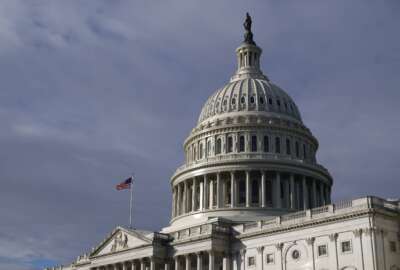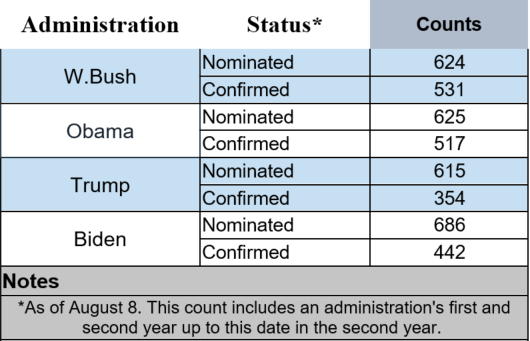
Five federal workforce items on Congress’ to-do list
Congress has a lot on its plate to try to avoid a continuing resolution, including a host of appropriations bills.
With the end of fiscal year 2022 approaching and a Sept. 30 deadline, Congress still has a lot on its plate to avoid a continuing resolution (CR), or potentially a government shutdown.
Although some lawmakers have said a CR is already nearly inevitable, there are several key components on Congress’ to-do list when the House and Senate return from the August recess.
Appropriations bills
So far, the House passed six of its 12 spending bills for fiscal 2023 on July 20. Senate Democrats also released draft legislation for the 12 companion appropriations bills on July 28.
If any of the 12 bills don’t pass Congress by the end of September, lawmakers will likely put forward a CR for those components. CRs are common; the federal government has operated on them for all but three of the last 46 years, the Government Accountability Office reported on Aug. 1.
For federal agencies, a CR would mean temporarily continuing the same funding levels from last fiscal year. Federal unions, like the National Treasury Employees Union, said CRs have severe impacts on agencies’ functions.
“Too many federal agencies are still suffering from several years of budget cuts or flat budgets that have stalled hiring and affected the ability to deliver on their missions,” NTEU National President Tony Reardon wrote in an email to Federal News Network.
The House already passed the 2023 financial services and general government appropriations bill, but Senate Democrats’ version is still in its draft form. Neither the House nor the Senate mentioned the White House’s 4.6% federal pay raise proposal in the spending bill, meaning they aligned with that across-the-board percentage.
NTEU, though, said it will continue to push for a higher pay raise for federal employees next year.
“NTEU is supporting the 5.1% average pay raise for federal employees in 2023 as contained in the FAIR Act,” Reardon wrote. “Given the ongoing disparity between public and private-sector salaries, and rising costs, we believe a 5.1% pay increase is absolutely warranted.”
In their draft appropriations bill, Senate Democrats also included a lift on the pay freeze for senior political appointees, a provision that has remained in place since at least 2014.
National Defense Authorization Act and Schedule F
The National Defense Authorization Act for fiscal 2023 passed the House on July 14, which would appropriate roughly $840 billion in national defense spending. It also included several provisions directly impacting the federal workforce.
The bill aligned with the White House’s 4.6% pay raise request for military personnel, a step toward the same pay raise for civilian feds. Another provision in the legislation would establish a $15 minimum wage for federal contractors.
Part of the House’s version of NDAA, which Rep. Gerry Connolly (D-Va.) introduced, would block the return of Schedule F, a now-rescinded Trump-era executive order that would make roughly 50,000 feds at-will workers. Similar language to try to prevent Schedule F was also included in Senate Democrats’ financial services and general government appropriations bill.
Republican lawmakers, though, proposed legislation that would put in place regulations similar to what Schedule F previously allowed. Rep. Chip Roy (R-Texas) introduced legislation to abolish the Merit Systems Protection Board, an agency created to let federal employees appeal firings or workplace retaliation. The bill, however, is unlikely to make it through Congress with Republicans currently in the minority in both houses.
Social Security Fairness Act
A key piece of bipartisan legislation that’s gained traction would repeal two provisions that either reduce or eliminate Social Security benefits for retired federal employees and their spouses.
The Social Security Fairness Act, which Rep. Rodney Davis (R-Ill.) introduced and Rep. Abigail Spanberger (D-Va.) sponsored, recently surpassed 290 co-sponsors. John Hatton, staff vice president for policy and programs at the National Active and Retired Federal Employees Association, told Federal News Network that the high number of co-sponsors could propel the bill to a House floor vote.
“With recent House rules changes, securing more than 290 cosponsors has real significance,” Hatton said. “Congressman Davis has filed a motion to add the bill to the House consensus calendar, which may force either a House vote or committee action.”
The bill would remove both the Windfall Elimination Provision (WEP) and the Government Pension Offset (GPO). The WEP reduces Social Security benefits for federal retirees in the Civil Service Retirement System (CSRS), who have earned both a CSRS pension and Social Security benefits through private sector work. The GPO reduces Social Security benefits for spouses, widows and widowers of federal retirees affected by the WEP.
“Both the WEP and the GPO have unfairly penalized federal retirees for decades,” Hatton said. “In some cases, GPO completely eliminates Social Security survivor benefits for widows. House members have shown high levels of support for repeal of these provisions in the past.”
The Senate also introduced companion legislation for the Social Security Fairness Act.
Equal COLA Act
The Equal COLA Act received some attention this year in Congress, with high inflation levels over the last several months.
Currently, CSRS retirees and Social Security beneficiaries receive cost of living adjustments, or COLAs, that match inflation levels. After Congress switched federal employees to a new retirement system during the 1980s, retirees under the Federal Employee Retirement System now receive a smaller COLA, with the exact deduction dependent on how high inflation is in a given year.
The Equal COLA Act would remove the disparity between COLAs for FERS and CSRS retirees.
“With inflation as high as it’s been for decades, FERS retirees are seeing the value of their hard-earned retirement benefits erode as prices rise,” Hatton said. “Without an adequate COLA for two years and counting, a key component of their retirement income will continue to weaken.”
Senate confirmations
Out of roughly 4,000 politically appointed positions at agencies, around 1,200 of those roles require Senate confirmation after the president picks a nominee. So far, for the Biden administration, the Senate has confirmed 442 positions.
The chart below, which Federal News Network obtained from the Partnership for Public Service, shows the Biden administration’s progress in Senate nominations and confirmations compared with other recent administrations.

The Partnership for Public Service, in collaboration with the Washington Post, also have a tracker of how many key roles Biden has filled to date. You can see that tracker here.
In addition to Senate confirmations, the Partnership’s President and CEO Max Stier wrote in an email to Federal News Network that passing Congressional spending bills on time is key to ensuring agencies’ effectiveness.
“Keeping the government’s lights on is one of Congress’ most important and basic functions,” Stier wrote. “Patchwork funding by continuing resolution takes our civil service’s focus away from solving the many problems they confront every day, threatens the effective delivery of services the public depends on and wastes government resources. On-time passage of funding bills is not only the right thing to do, it also makes good fiscal sense.”
Copyright © 2025 Federal News Network. All rights reserved. This website is not intended for users located within the European Economic Area.
Drew Friedman is a workforce, pay and benefits reporter for Federal News Network.
Follow @dfriedmanWFED
Related Stories




